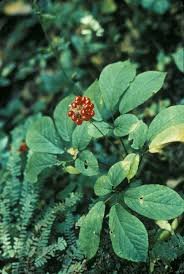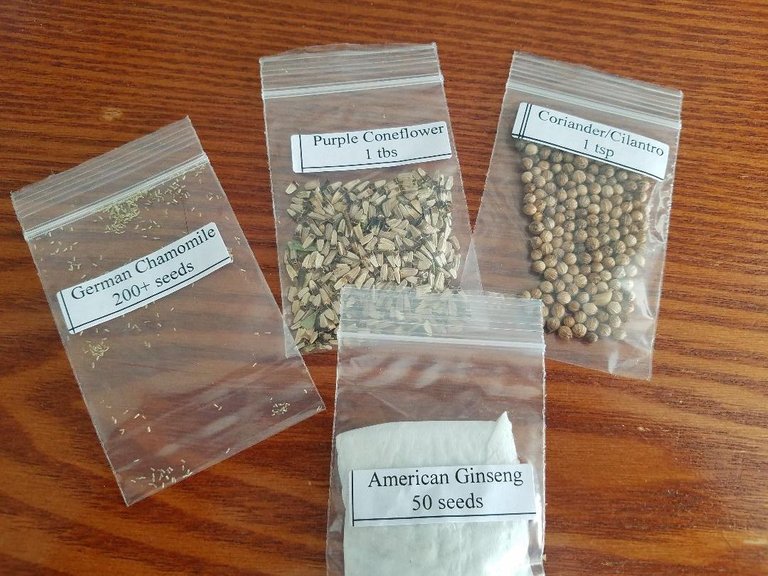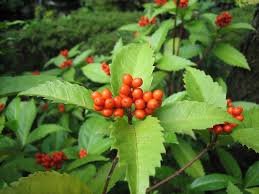Growing American Ginseng

seed swap and just got my latest seed packets in the mail today and was real curious about one of them; American Ginseng. So I started my research and now I'm waiting to see the perfect location to plant the seedlings once they are ready.I belong to @sotall's
We have a creek at the western edge of our property and it does have a slope downward; so after reading about the best locations for growing Ginseng, I am thinking this is more than likely the spot I will plant the seeds come this fall. From what I have read, ginseng prefers the colder temperatures and needs to be dormant over the winter.

What You Need To Know About American Ginseng
Where to plant ginseng for best growth, maturation and harvest:
- Tall shade (which is given by tall trees of a mature forest)
- Soil containing equal parts of sand and silt soil (preferably with high calcium levels but a low pH)
- Good air flow (ie. bottom of a hill or slope)
- Morning sunshine is preferred with a north-facing slope; or even west facing
Companion Plants & Trees
- Trees with leaves that break down/compost easy (ie. beech, maple, pawpaw or poplar
- Plants American Ginseng prefer are goldenseal, black cohosh and ferns

According to the North Carolina Extension,
Ginseng (Panax quinquefolium) is most commonly propagated by seed. The seeds require special handling because, to germinate, they must first be subjected to a long period of storage in a moist medium with a warm/cold treatment; a process known as stratification
So what is stratification?
The main definition is as follows:
In the wild, seed dormancy is usually overcome by the seed spending time in the ground through a winter period and having its hard seed coat softened up by frost and weathering action. By doing so the seed is undergoing a natural form of "cold stratification" or pretreatment. This cold moist period triggers the seed's embryo; its growth and subsequent expansion eventually break through the softened seed coat in its search for sun and nutrients.
The basic explanation of cold stratification is keeping the seeds cold (but not freezing) and also moist for specific amount of time. All seeds that need to have cold stratification are different, so make sure to read up and research the time frame and appropriate instructions.


I'm not exactly sure what I will use the ginseng for yet, but some of the ailments it can be used for include:
- Anti-inflammatory
- Cognitive focus
- More energy
- Lowering blood sugar
- Cholesterol lowering properties
- Stress relief





Nice photogrophy
I have a Ginseng but not an American Ginseng!!!
I have never grown this before but I have seen some information on TV about it (ie, energy drinks and supplemental pills, etc) so this should be interesting
Ginseng is very popular here in china. It's often used in some homemade herbals. I am learning a lot from natives about these things. It's interesting to see that there is ginseng in america too. :)
Rydhi
xox
Filthy rich has some people that harvest ginseng. I never knew, but apparently energy drink makers pay good money for it.
I have heard for the older roots (I believe ten years worth of growth) you can get premium $$ for. But I have never grown it and need to make sure it will survive in my zone. That's my only concern.
That was interesting to read. I've never been a very good at growing things, but that needs to change in the future! :)
I never was good either- when I was in my early 20s, my dad had given me a cactus in a terrarium. Sad to say but I killed the cacti. That was horrible! But now I can grow MANY things and continually add to my garden, herbs and flower beds.
With posting like this is very helpful for members who are still lower level like me. thank you @goldendawne..!
Well that's timely. I just planted two packs of ginseng seeds. A woman nearby gives them away to promote people growing them. She told me 95%of the ginseng cultivated goes to Red Bull drinks and only the wild ginseng is expensive since it takes many many years to get big roots. However some of the largest wildnones found sell to Chinese buyers for thousands of dollars! Seems like most of the wild ginseng has been cleaned out in our area.
WOW! I wonder how much is the actual going price then.
I was thinking it would be good for my herbal teas and add a zippy flavor like ginger does.
The price of wild ginseng roots has climbed in the last decade. Now domestic buyers pay $500 to $600 per pound compared with about $50 per pound of cultivated roots. Source
That was 2012 and I understand it's more now.
WOW! That is amazing!
I can't believe those numbers! From 6 years ago too!
We have planted many American Ginseng seeds in our sugar maple stand over the past four years and have only seen a few come up. Hoping a few grow to give us more seeds to plant. Good luck nice post
So their retention for growth, pending on where they are planted, is not the best?
If I can sprout a few I'll be happy. I doubt I'll plant all 50 seeds; I may do a dozen and wait to see the results first before I attempt more. I know they can take years to actually grow into something worthwhile.
From what we understand the seeds need to be planted right away or they dry out and die. Maybe freeze them, would look into storage if you keep .
Good luck
I wonder if it would grow in Canada?
I haven't tried ginseng here because I think it is too hot here. It may also be too wet in rainy season...